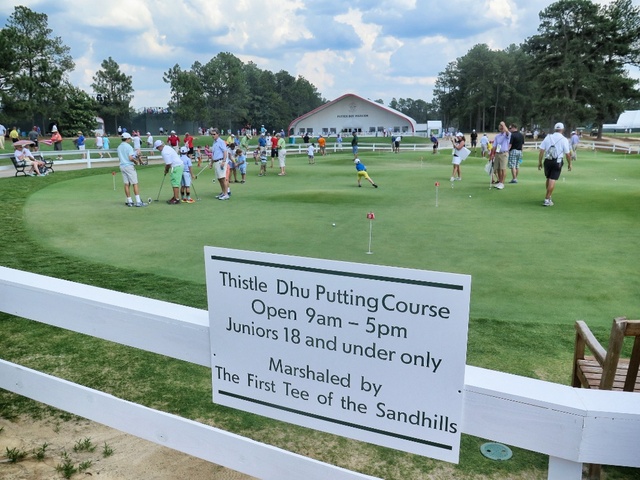Even though I was here in February, the look and conditions of Pinehurst No. 2 exceeded my highest expectations Monday, which I noted with Gary Williams on Morning Drive.
The sandy areas of Pinehurst No. 2 are rightfully getting all of the attention because of the way they've transformed the look here. The recapturing of sand, interspersed with thousands of plantings, gives the impression of weathering and maturation even though it's only been a little over two years of growing time. (Toby Cobb spearheaded this effort for Coore and Crenshaw and deserves great credit for such an artisinal touch in the planting, followed by deft maintenance by the No. 2 crew).
 (Click on image to enlarge)But after walking the course again Monday of U.S. Open week, attention should turn to the transition zones from fairway to the sandy scrub. They should not pose a rules issue but these transitions will be noticed in HD, perhaps to a point that people think it's poor maintenance by super Kevin Robinson and crew. The opposite is the case: the pine scrub areas are the work of a master maintenance and irrigation design team.
(Click on image to enlarge)But after walking the course again Monday of U.S. Open week, attention should turn to the transition zones from fairway to the sandy scrub. They should not pose a rules issue but these transitions will be noticed in HD, perhaps to a point that people think it's poor maintenance by super Kevin Robinson and crew. The opposite is the case: the pine scrub areas are the work of a master maintenance and irrigation design team.
To create a gentle shift from fairway to scrub takes artistry on a scale we rarely experience. How many times have you played a course lined by native areas, only to find the first five to ten feet more dense than areas well off the beaten path? All because of faulty irrigation design sending overspray into those natives. This is traditionally driven by the weird obsession with covering every inch of a property in irrigation "coverage," even at the expense of playability.
Pinehurst's return to a single row of irrigation heads that reduced the number by 700, has been key to the impressive playability of the transitions. The lack of a sharp contrast between fairway and scrub is beautiful to those who love their golf natural, though the look of the occasional exposed sand where there "should" be fairway may prompt cow pasture lines in 19th holes across the land. But we'd rather see a transition of sand and grass than tall stuff just off to the sides of play. The look also exudes naturalness. History tells us that the more natural a course seems or looks, the more we accept the arbitrary nature of things such as "waste" hazards.
So if you hear people criticizing the brown and rugged Pinehurst, remind them that it's all about accentuating the playability of Donald Ross's design. Even if the initial impression may not seem like the lush beauty that golf grew addicted to, to some of us the imperfection is just perfect.
 The Matthew Goldstein and Ben Protess story which, while still suggesting Phil Mickelson may have issues related to his Dean Foods trades that netted him $1 million (to Billy Walters' $15 million), includes this:
The Matthew Goldstein and Ben Protess story which, while still suggesting Phil Mickelson may have issues related to his Dean Foods trades that netted him $1 million (to Billy Walters' $15 million), includes this:














